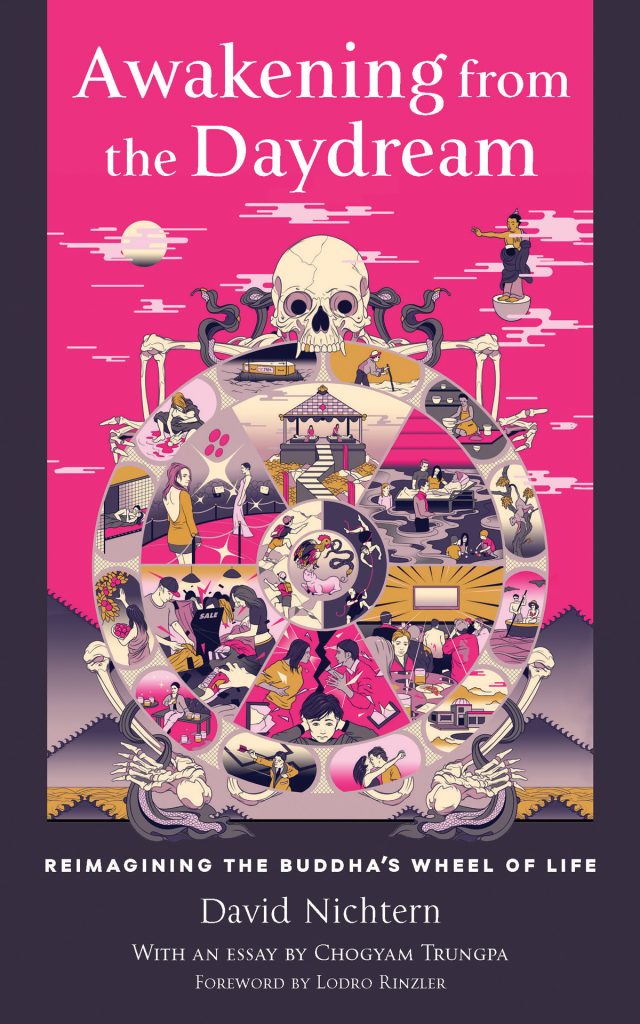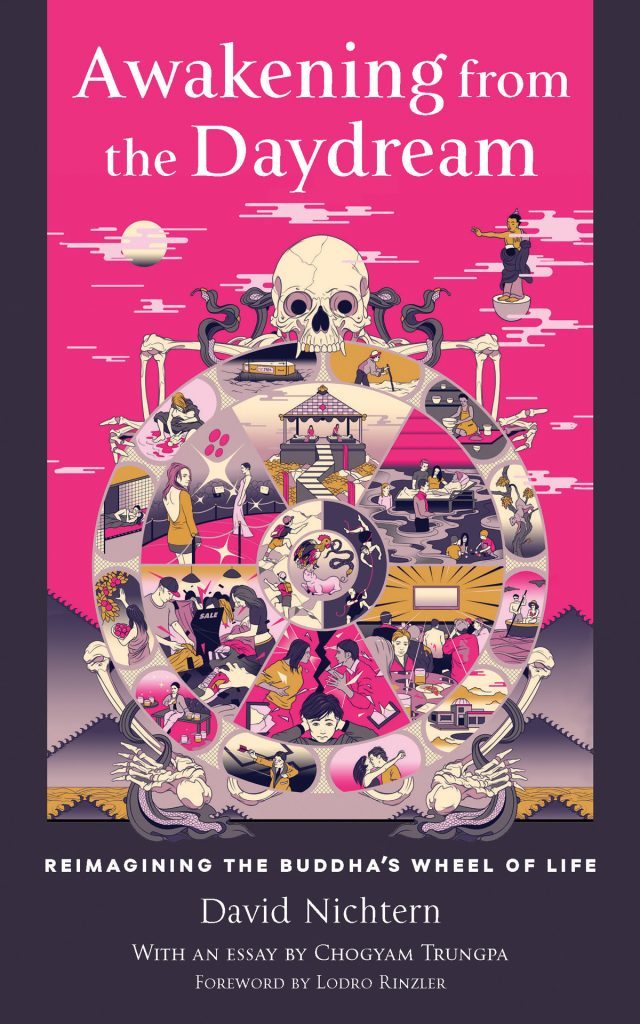You don’t have to be a rocket scientist to understand the Buddha’s teachings.
So says David Nichtern, a musician and senior teacher in the Shambhala lineage who began studying meditation with Chögyam Trungpa Rinpoche soon after the revered lama arrived in the United States in the 1970s.
In his first book, Awakening from the Daydream, Nichtern has written an accessible guide for the reader to better understand karma and the six realms of existence—god, jealous god, human, animal, hungry ghost, and hell.
These realms, Nichtern writes, depict the “diverse experiences” of our daily dramas. The bhavacakra, or “Wheel of Life,” is a visual representation of the six realms that adorn the walls of Tibetan Buddhist monasteries and temples, and the cover of Awakening from the Daydream features a contemporary take.
Nichtern recently sat down with Tricycle to discuss how the realms provide us with a ripe opportunity for practice and transformation.

You’ve been practicing for a long time, but this is your first book. Why did you decide to write about karma?
I had no particular intention to write a book, but this topic has been on my mind. In a way it’s haunted me since I took teachings on it from Trungpa Rinpoche in the summer of 1971, and I thought, “Oh, this is really colorful, vivid, juicy stuff.” The way I said it in the book is that I felt like it was “killing me softly with my own song” because it just hit target after target.
The wheel of life, the cycle of existence, is a portrait of samsara. You ever wake up in the morning and think, “Oh, here we go again?”—it’s that kind of cycle. It’s Groundhog Day. Our experience is not cyclic, but becomes cyclical because of our tendency to imprint patterns on our way of being. So what’s the problem with that? No problem, except that sometimes they are painful or people say, “I’m in a rut. I’m caught in this cycle.” So the six realms in the Wheel of Life are six ruts in a way.
Tell me about the cover of your book, which features a contemporary image of the Wheel of Life.
The original Wheel of Life image has people being flayed alive and having molten iron poured down their throats in the hell realm. On the cover of Awakening from the Daydream we have a kid covering his ears while his parents are screaming at each other. So we’re trying to make the imagery more accessible to contemporary people. I’m hoping that readers think, “Oh, I get that. I know what that feels like.” These realms are states of mind. Since you woke up this morning you’ve been in every one of them.
Is it possible to be in more than one realm at the same time?
It’s possible. A very wealthy person could have an external form of a god realm, but their state of mind could be hungry ghost or hell realm. We think, “Why? What’s the problem? You have everything; you have your own private plane, you have servants.” But the mind is not tracking to that. So some part of their karma got them to that realm and then another part is activating a different set of possibilities.
When you read about the realms there is a kind of self-diagnosis going on—what realm am I in?—almost like when you turn to Google or WebMD to find out what’s wrong with you physically.
Buddha was described as the “great physician.” As far as I’m concerned the entire Buddhist program is a remedy. It’s not intended to unnecessarily create more fabricated material for us to have to deal with. It’s addressing what we already have in front of us.
But first you have to look and say, “Am I stuck anywhere?” Easy to say if you’re in the lower realms—the hell realm or the hungry ghost realm—where you’re addicted, suffering, miserably depressed, or horribly enraged. In the god realms you feel like you don’t have any particular complaint and things are going extremely well. So it’s a much subtler trap. You can think of it like a golden mousetrap. It’s tricky to present the dharma to somebody who is in the god realm, because they just say, “I don’t get what the problem is.”
But the Buddhist view is using extreme discernment, or prajna—that’s your main weapon or tool to accurately look at a situation. The idea is that with a discerning eye you can look at the situation and be open and honest about it. Without self-reflection there is no dharma.
You said that Trungpa Rinpoche taught about the transformational quality of the six realms and the opportunity to practice while in them. Which realm presents a great opportunity to change?
The hungry ghost realm is the best. Craving has so much possibility to wake you up—that moment when you’re reaching for the refrigerator is one of the most powerfully flippable. You can use the energy to reside in that space instead of going for the object, such as a dessert. It’s not easy . . . but desire presents a very vivid opportunity to wake up.
What do you hope that readers take away from your book?
Is buddhadharma really that complicated? Is it something that only rocket scientists should be talking about? There is an almost oppressive feeling that some part of it has been shepherded into that domain.
But the great teachers that I have met are so accessible. The dharma is sometimes called “grandmother’s wisdom,” because the best teachings are so earthy and practical. Part of what I want to do is try to reach the people who are intelligent enough to understand the teachings but are too wrapped up in the mad scramble of their everyday lives to prioritize it.
There is a rocket science dimension, however, in regard to how the mind occurs. They say a mental imprint is about 124th of a second long. So you’ve had 124 mental imprints in the last second alone, like frames of film. Within the tradition, people who have cleared their minds have become very precise about what’s going on in the mind and how it’s constructed. They can go deep into their minds and not get hung up or feel trapped. They can slow down, be kind, and develop some curiosity about how their situation has evolved and can evolve.
Awakening from the Daydream is available from Wisdom Publications.
(This interview has been edited for length and clarity.)
Thank you for subscribing to Tricycle! As a nonprofit, we depend on readers like you to keep Buddhist teachings and practices widely available.
